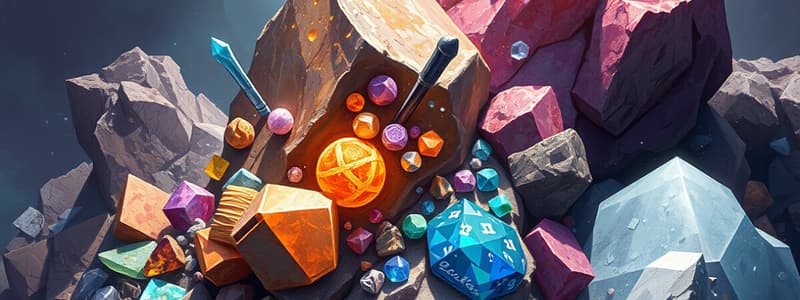Podcast
Questions and Answers
What is the basis of mineral classification?
What is the basis of mineral classification?
- Chemical composition (correct)
- Color
- Density
- Physical properties
How are minerals classified?
How are minerals classified?
Minerals are split up into classes depending on the dominant anion or anionic group.
Why do minerals having the same anion have stronger resemblances?
Why do minerals having the same anion have stronger resemblances?
Because they have the same anion or anionic group in their composition.
What is a reason that minerals related by dominance of the same anion tend to occur together?
What is a reason that minerals related by dominance of the same anion tend to occur together?
What does the scheme of mineral classification agree with?
What does the scheme of mineral classification agree with?
What are native elements?
What are native elements?
What are sulfide minerals?
What are sulfide minerals?
What are phosphates, arsenates, and vanadates composed of?
What are phosphates, arsenates, and vanadates composed of?
Describe the sulfate anionic group.
Describe the sulfate anionic group.
What does the boron atom join with to form the borate radical?
What does the boron atom join with to form the borate radical?
What do nitrates involve in their composition?
What do nitrates involve in their composition?
What are carbonites?
What are carbonites?
What characterizes halides?
What characterizes halides?
What do hydroxides consist of?
What do hydroxides consist of?
What is the defining feature of oxides?
What is the defining feature of oxides?
What forms the fundamental constituent of silicates?
What forms the fundamental constituent of silicates?
Describe nesosilicates.
Describe nesosilicates.
What do sorosilicates consist of?
What do sorosilicates consist of?
What defines inosilicates?
What defines inosilicates?
What are cyclosilicates characterized by?
What are cyclosilicates characterized by?
What do phylosilicates form?
What do phylosilicates form?
What do tecosilicates consist of?
What do tecosilicates consist of?
What are solfosalts?
What are solfosalts?
Flashcards are hidden until you start studying
Study Notes
Classification of Minerals
- Mineral classification is primarily based on chemical composition.
- Minerals are categorized depending on the dominant anion or anionic group present in their structure.
Classification by Anions
- Minerals sharing the same anion exhibit stronger similarities than those sharing the same cation.
- Minerals with a common anion often coexist in similar geological environments, highlighting their relatedness.
- This classification aligns with contemporary chemical practices in naming and categorizing inorganic compounds.
Types of Minerals
- Native Elements: Minerals formed entirely from uncombined elements, including metals, semi-metals, and non-metals.
- Sulfides: Composed of metallic cations and are significant sources of ore.
- Phosphates, Arsenates, and Vanadates: Comprise phosphorus, arsenic, and vanadium with tetrahedral anionic groups bonded with oxygen.
- Sulfates: Feature the sulfate anionic group (SO4) formed by sulfur cation bonded with four oxygen anions.
- Borates: Created when boron combines with three oxygen atoms to form borate radicals.
- Nitrates: Contain nitrogen bonded to three oxygen atoms, analogous to carbonates.
- Carbonates: Combinations of metals or semi-metals with the carbonate anion (CO3).
- Halides: Minerals where an anion is derived from a halogen element.
- Hydroxides: Composed of metallic elements combined with hydroxyl ions or water.
- Oxides: Forms where an oxygen anion combines with one or more metallic elements.
Silicate Minerals
- Silicates: Classified by the silicate radical (SiO4), which forms a tetrahedral geometry with oxygen anions surrounding a central silicate cation.
- Nesosilicates: Feature isolated silicate groups.
- Sorosilicates: Composed of paired silicate groups.
- Inosilicates: Include single and double chain silicate structures.
- Cyclosilicates: Form rings of silicate groups.
- Phylosilicates: Arranged in sheets of silicate layers.
- Tecosilicates: Form a three-dimensional framework of interconnected silicate groups.
Solfosalts
- Composed of sulfur in combination with a semi-metal (such as arsenic) and one or more metals.
Studying That Suits You
Use AI to generate personalized quizzes and flashcards to suit your learning preferences.




